
Digital Equipment Corporation, using the trademark Digital, was a major American company in the computer industry from the 1960s to the 1990s. The company was co-founded by Ken Olsen and Harlan Anderson in 1957. Olsen was president until forced to resign in 1992, after the company had gone into precipitous decline.
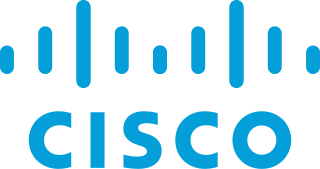
Cisco Systems, Inc., commonly known as Cisco, is an American-based multinational digital communications technology conglomerate corporation headquartered in San Jose, California. Cisco develops, manufactures, and sells networking hardware, software, telecommunications equipment and other high-technology services and products. Cisco specializes in specific tech markets, such as the Internet of Things (IoT), domain security, videoconferencing, and energy management with leading products including Webex, OpenDNS, Jabber, Duo Security, and Jasper. Cisco is one of the largest technology companies in the world ranking 74 on the Fortune 100 with over $51 billion in revenue and nearly 80,000 employees.
VME is a mainframe operating system developed by the UK company International Computers Limited. Originally developed in the 1970s to drive ICL's then new 2900 Series mainframes, the operating system is now known as OpenVME incorporating a Unix subsystem, and runs on ICL Series 39 and Trimetra mainframe computers, as well as industry-standard x64 servers.
PeopleSoft, Inc. is a company that provides human resource management systems (HRMS), financial management solutions (FMS), supply chain management (SCM), customer relationship management (CRM), and enterprise performance management (EPM) software, as well as software for manufacturing, and student administration to large corporations, governments, and organizations. It existed as an independent corporation until its acquisition by Oracle Corporation in 2005. The PeopleSoft name and product line are now marketed by Oracle.

McAfee Corp., formerly known as McAfee Associates, Inc. from 1987 to 1997 and 2004 to 2014, Network Associates Inc. from 1997 to 2004, and Intel Security Group from 2014 to 2017, is an American global computer security software company headquartered in San Jose, California.

Carrier Routing System (CRS) is a modular and distributed core router developed by Cisco Systems Inc that enables service providers to deliver data, voice, and video services over a scalable IP Next-Generation Network (NGN) infrastructure. In a network topology, these routers are generally positioned in the core or edge of a service provider network. They are also used by Over-the-top content providers and large enterprises. It supports a wide range of interface speeds and types such as channelized OC3, OC12 to OC768 on Packet over SONET and from 1GE, 10GE all the way to 100GE on the Ethernet technologies. A standalone CRS-3 system can handle 2.2Tbit/s and a multi-chassis system could be designed to handle 322Tbit/s.
NetApp, Inc. is an American data storage and data management services company headquartered in San Jose, California. It has ranked in the Fortune 500 from 2012 to 2021. Founded in 1992 with an initial public offering in 1995, NetApp offers cloud data services for management of applications and data both online and physically.
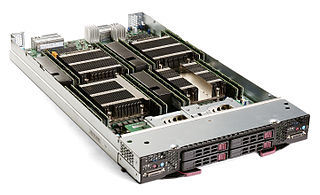
A blade server is a stripped-down server computer with a modular design optimized to minimize the use of physical space and energy. Blade servers have many components removed to save space, minimize power consumption and other considerations, while still having all the functional components to be considered a computer. Unlike a rack-mount server, a blade server fits inside a blade enclosure, which can hold multiple blade servers, providing services such as power, cooling, networking, various interconnects and management. Together, blades and the blade enclosure form a blade system, which may itself be rack-mounted. Different blade providers have differing principles regarding what to include in the blade itself, and in the blade system as a whole.

Catalyst is the brand for a variety of network switches, wireless controllers, and wireless access points sold by Cisco Systems. While commonly associated with Ethernet switches, a number of different types of network interfaces have been available throughout the history of the brand. Cisco acquired several different companies and rebranded their products as different versions of the Catalyst product line. The original Catalyst 5000 and 6000 series were based on technology acquired from Crescendo Communications. The 1700, 1900, and 2800 series Catalysts came from Grand Junction Networks, and the Catalyst 3000 series came from Kalpana in 1994.
Brocade is an American technology company specializing in storage networking products, now a subsidiary of Broadcom Inc. The company is known for its Fibre Channel storage networking products and technology. Prior to the acquisition, the company expanded into adjacent markets including a wide range of IP/Ethernet hardware and software products. Offerings included routers and network switches for data center, campus and carrier environments, IP storage network fabrics; Network Functions Virtualization (NFV) and software-defined networking (SDN) markets such as a commercial edition of the OpenDaylight Project controller; and network management software that spans physical and virtual devices.

F5, Inc. is an American technology company specializing in application security, multi-cloud management, online fraud prevention, application delivery networking (ADN), application availability & performance, network security, and access & authorization.

Modular design, or modularity in design, is a design principle that subdivides a system into smaller parts called modules, which can be independently created, modified, replaced, or exchanged with other modules or between different systems.
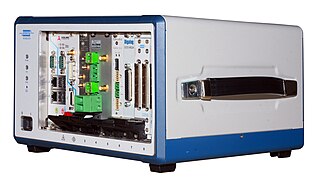
PCI eXtensions for Instrumentation (PXI) is one of several modular electronic instrumentation platforms in current use. These platforms are used as a basis for building electronic test equipment, automation systems, and modular laboratory instruments. PXI is based on industry-standard computer buses and permits flexibility in building equipment. Often, modules are fitted with custom software to manage the system.
Machine to machine (M2M) is direct communication between devices using any communications channel, including wired and wireless. Machine to machine communication can include industrial instrumentation, enabling a sensor or meter to communicate the information it records to application software that can use it. Such communication was originally accomplished by having a remote network of machines relay information back to a central hub for analysis, which would then be rerouted into a system like a personal computer.
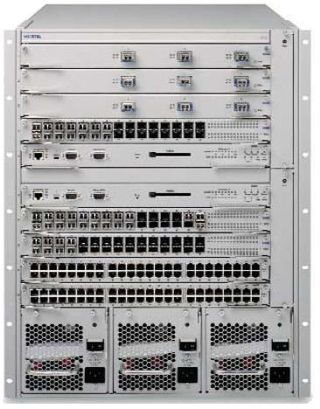
The Avaya Ethernet Routing Switch 8600 or ERS 8600, previously known as the Passport 8600 or the Accelar 8000, is a modular chassis combination hardware router and switch used in computer networking. The system, originally designed and manufactured by Nortel, was manufactured by Avaya from 2009 until 2017. The system provided the 10G Ethernet equipment backbone for the 2010 Winter Olympics games, providing service for 15,000 VoIP Phones, 40,000 Ethernet connections and supporting 1.8 million live spectators. The system is configurable as a 1.440 Terabit Switch cluster using SMLT and R-SMLT protocols, to provide high reliability cluster failover.
Dell Force10, was a United States company that developed and marketed 10 Gigabit and 40 Gigabit Ethernet switches for computer networking to corporate, educational, and governmental customers. It had offices in North America, Europe, and the Asia Pacific region.
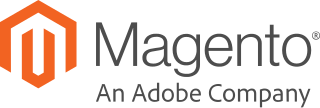
Magento is an open-source e-commerce platform written in PHP. It uses multiple other PHP frameworks such as Laminas and Symfony. Magento source code is distributed under Open Software License (OSL) v3.0. Magento was acquired by Adobe Inc in May 2018 for $1.68 billion.

Blue Coat Systems, Inc., was a company that provided hardware, software, and services designed for cybersecurity and network management. In 2016, it was acquired by and folded into Symantec. In 2019 was, as part of Symantec Enterprise division, sold to Broadcom.
Arista Networks is an American computer networking company headquartered in Santa Clara, California. The company designs and sells multilayer network switches to deliver software-defined networking (SDN) for large datacenter, cloud computing, high-performance computing, and high-frequency trading environments. These products include 10/25/40/50/100 Gigabit Ethernet/200/400/800 low-latency cut-through switches, including the 7124SX, which remained the fastest switch using SFP+ optics through September 2012 with its sub-500 nanosecond (ns) latency, and the 7500 series, Arista's modular 10G/40G/100Gbit/s switch. Arista's Linux-based network operating system, Extensible Operating System (EOS), runs on all Arista products.
Utimaco Atalla, founded as Atalla Technovation and formerly known as Atalla Corporation or HP Atalla, is a security vendor, active in the market segments of data security and cryptography. Atalla provides government-grade end-to-end products in network security, and hardware security modules (HSMs) used in automated teller machines (ATMs) and Internet security. The company was founded by Egyptian engineer Mohamed M. Atalla in 1972. Atalla HSMs are the payment card industry's de facto standard, protecting 250 million card transactions daily as of 2013, and securing the majority of the world's ATM transactions as of 2014.











